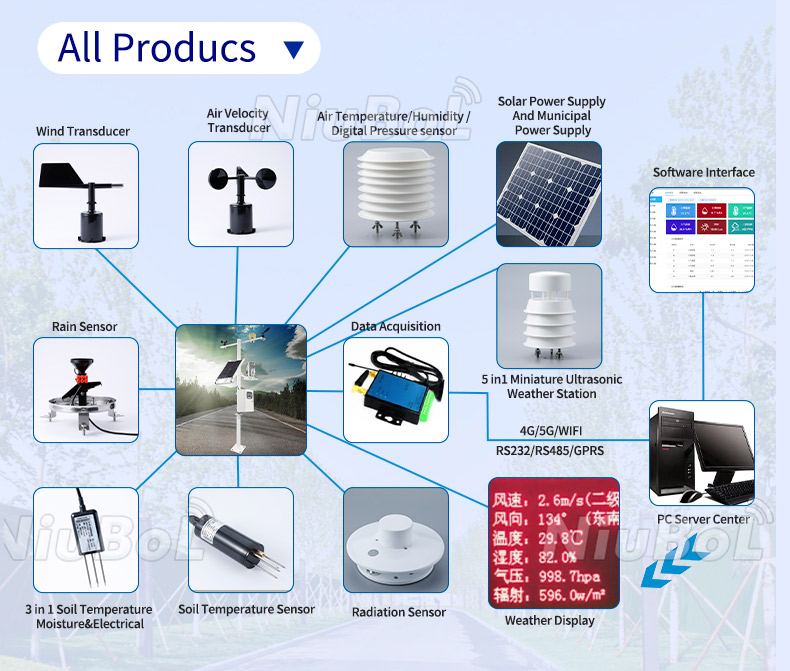

— Blogs —
—Products—
 Consumer hotline +8618073152920
Consumer hotline +8618073152920 WhatsApp:+8615367865107
Address:Room 102, District D, Houhu Industrial Park, Yuelu District, Changsha City, Hunan Province, China
Product knowledge
Time:2024-01-23 14:24:18 Popularity:1569
IoT (Internet of Things) Agricultural Sensors are sensor devices used in agriculture that are connected to the Internet through IoT technology and are able to collect, transmit and analyze agriculture-related data. These sensors can be installed in farmlands, greenhouses, livestock farms, etc. and are used to monitor and control the growing environment of crops, soil conditions, weather parameters, etc.
A soil moisture sensor is a device used to measure the moisture content of the soil, which is usually realized through the principle of capacitance or resistance. These sensors can be installed in agricultural fields to help farmers determine irrigation needs and avoid over- or under-irrigation. Some advanced soil moisture sensors are also capable of measuring parameters such as soil temperature and salinity.
2. Temperature and humidity sensors
Temperature and humidity sensors are used to monitor ambient temperature and humidity to optimize crop growing conditions. These sensors typically use thermistors or thermocouples to measure temperature and capacitors or resistors to measure humidity. Farmers can use this data to adjust the temperature and humidity in the greenhouse or conservatory to improve crop yield and quality.
3. Illumination Sensors
Illumination Sensors are used to measure light intensity and are usually realized using photodiodes or photoresistors. Farmers can install these sensors in their greenhouses or conservatories to control light conditions for their crops. For example, on cloudy or rainy days, adequate light can be provided by controlling the switching of lights.
4. Wind speed and direction sensors
Wind speed and direction sensors are used to monitor wind speed and direction and are usually implemented using technologies such as rotating blades or ultrasound. Farmers can install these sensors around their farmland to predict wind hazards that may affect crop growth, such as wind shear and drying, and take appropriate wind protection measures.
5. pH sensors
pH sensors are used to measure the acidity or alkalinity of the soil and are usually implemented using glass or membrane electrodes. Farmers can use these sensors to determine the pH of the soil and adjust the soil's acidity or alkalinity according to the growing needs of the crop. For example, when growing an acidic crop, such as blueberries, the pH of the soil can be raised by adding lime or other alkaline substances.
6. Weather station sensors
Weather station sensors include measurements of parameters such as temperature, humidity, barometric pressure, and rainfall to provide comprehensive weather data. Farmers can install these sensors in their farmland to keep abreast of current weather conditions and make decisions accordingly based on predicted weather conditions, such as adjusting irrigation schedules or taking rain protection measures.
Real-time monitoring: IoT agriculture sensors can monitor various parameters in the agricultural environment in real-time, helping farmers to keep abreast of crop growth, detect abnormalities and take appropriate measures.
Yield improvement: By monitoring and adjusting the parameters in the agricultural environment, it can help farmers optimize the crop growing environment and improve crop yield and quality.
Cost saving: IoT agriculture sensors can reduce the frequency and cost of manual inspection, while improving the accuracy and reliability of monitoring data, helping farmers to conduct agricultural production more scientifically.
Intelligent management: IoT agriculture sensors can be combined with IoT technology to realize remote monitoring and automated management, improving the intelligent level of agricultural production.
Data traceability: The data collected by IoT agriculture sensors can be stored in the cloud platform or data center, which is convenient for farmers to analyze and trace the data, providing a more scientific and reliable basis for agricultural production.

In conclusion, IoT agriculture sensors are one of the important means to realize smart agriculture, these IoT agriculture sensors can be integrated with cloud platform or agriculture management system to realize remote monitoring and data analysis, which can help farmers to optimize the agricultural production process, improve the yield and quality, and reduce the consumption of resources and environmental impact. It can help farmers conduct agricultural production more scientifically and efficiently, and improve the efficiency and competitiveness of agricultural production.
Related recommendations
Sensors & Weather Stations Catalog
Agriculture Sensors and Weather Stations Catalog-NiuBoL.pdf
Weather Stations Catalog-NiuBoL.pdf
Related products
 Combined air temperature and relative humidity sensor
Combined air temperature and relative humidity sensor Soil Moisture Temperature sensor for irrigation
Soil Moisture Temperature sensor for irrigation Soil pH sensor RS485 soil Testing instrument soil ph meter for agriculture
Soil pH sensor RS485 soil Testing instrument soil ph meter for agriculture Wind Speed sensor Output Modbus/RS485/Analog/0-5V/4-20mA
Wind Speed sensor Output Modbus/RS485/Analog/0-5V/4-20mA Tipping bucket rain gauge for weather monitoring auto rainfall sensor RS485/Outdoor/stainless steel
Tipping bucket rain gauge for weather monitoring auto rainfall sensor RS485/Outdoor/stainless steel Pyranometer Solar Radiation Sensor 4-20mA/RS485
Pyranometer Solar Radiation Sensor 4-20mA/RS485
Screenshot, WhatsApp to identify the QR code
WhatsApp number:+8615367865107
(Click on WhatsApp to copy and add friends)
